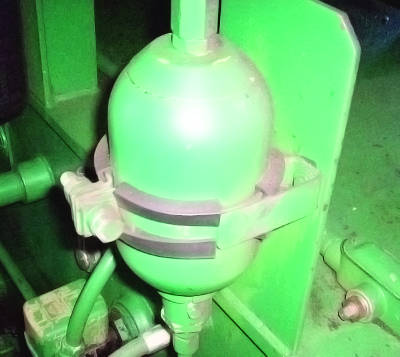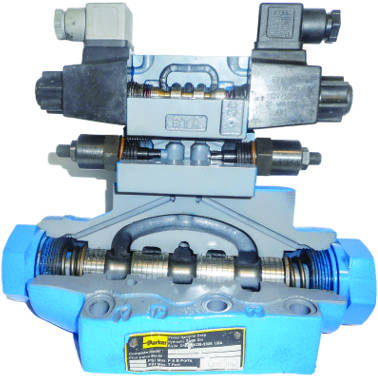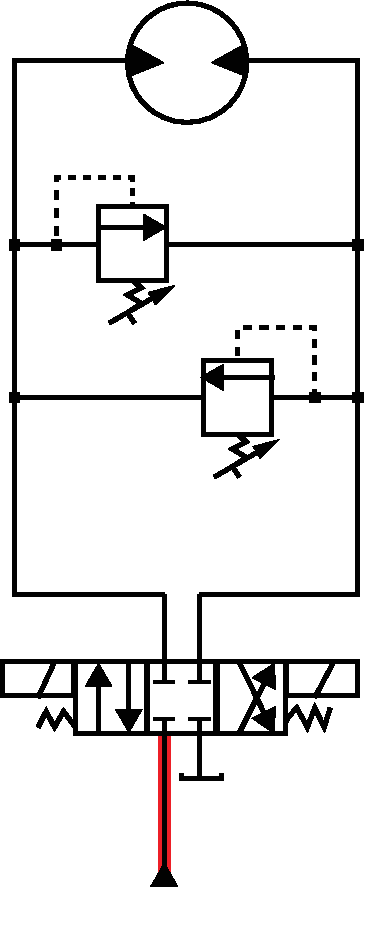3 Ways to Reduce Hydraulic Shock
Hydraulic shock occurs when oil rapidly starts or stops flowing in a hydraulic system. The oil flow rate in the pressure line of systems below 3,000 psi is usually 15-20 feet per second. In systems above 3,000 psi, the flow rate can be as high as 30 feet per second. Shock can also occur when an external force acts on a hydraulic cylinder or motor.
 Unlike air, hydraulic oil is generally considered to be non-compressible. Oil will only compress one-half of a percent when pressurized to 1,000 psi. When a pressure spike occurs in the system, the pressure can increase four or five times above the normal operating pressure. Since the average duration of a shock spike is 25 milliseconds, the pressure gauge cannot respond fast enough to give an accurate indication. Pressure transducers are normally used to record pressure spikes.
Unlike air, hydraulic oil is generally considered to be non-compressible. Oil will only compress one-half of a percent when pressurized to 1,000 psi. When a pressure spike occurs in the system, the pressure can increase four or five times above the normal operating pressure. Since the average duration of a shock spike is 25 milliseconds, the pressure gauge cannot respond fast enough to give an accurate indication. Pressure transducers are normally used to record pressure spikes.
Shock spikes that are not properly dampened or absorbed can result in leakage and damage to the lines and components in the system. This article will look at three things that can be done to reduce hydraulic shock.
Install an Accumulator
A hydraulic accumulator is pre-charged with dry nitrogen. Some type of separating device such as a piston, bladder or diaphragm is used to separate the nitrogen from the hydraulic oil inside the accumulator. A bladder (Figure 1) or diaphragm type is recommended to absorb shock. Both of these accumulators contain rubber elements that will be compressed when the hydraulic pressure rises above the dry nitrogen pre-charge. Depending on the system, the accumulator should be pre-charged to 100 psi below to 200 psi above the maximum operating pressure in the system. Accumulators that are used for shock can be small in size, usually one quart to one gallon.
 The accumulator should be installed as close as possible to where the shock spike is occurring. For example, if the pressure spike takes place when a cylinder fully extends, the accumulator should be installed near the port connected to the full piston side of the cylinder.
The accumulator should be installed as close as possible to where the shock spike is occurring. For example, if the pressure spike takes place when a cylinder fully extends, the accumulator should be installed near the port connected to the full piston side of the cylinder.
Accumulators are often used to absorb high flow surges in return lines. In this case, the pre-charge should be lower than the maximum pressure rating of any return filters or heat exchangers located downstream. Any time an accumulator is used in the pressure line, an automatic and/or manual dump valve should be installed to bleed the hydraulic pressure down to zero once the system is turned off.
Add Directional Valve Pilot Chokes
A typical two-stage, hydraulic-piloted, solenoid-controlled directional valve is shown in Figure 2. The valve contains pilot chokes, which are located in the block between the pilot valve on top and the main spool on the bottom. The block includes two flow controls connected in a meter-out arrangement and two bypass check valves. When either of the pilot valve solenoids is energized, pilot pressure is ported through one of the internal check valves and to one side of the main spool. As the spool shifts, the oil in the pilot cavity on the opposite side flows through the flow control and back to the tank through the pilot valve. The setting of the flow control determines the rate that the main spool shifts. By allowing the spool to gradually shift, the pump volume is gradually ported through the valve and to the system.
Several years ago, I was asked to consult with an oriented strand board plant in Minnesota about reducing shock on its hot press. The lines had been welded many times over due to the leakage that occurred because of pressure spikes. The press used eight 109-gallon-per-minute vane pumps to supply a high volume of oil for closing the press. Directional valves, like the one shown in Figure 2, were used to port the pumps’ volume back to the tank when in idle mode and when no longer needed in the rams. When the command was given to close the press, it sounded like eight sledgehammers banging away on the reservoir. Once the press was closed and the solenoids were de-energized, a tremendous amount of vibration and shock occurred in the lines. This was due to the rapid change of flow direction from the pumps. Instead of going to the press, the pumps’ volume rapidly changed direction and returned to the tank through the dump valves. It took an entire day to adjust the pilot chokes on all eight pumps. At the end of the day, the pumps were coming in and unloading smoothly.
Pilot chokes are considered optional equipment on directional valves. On valves that do not have them, once the pilot valve solenoid is energized, pilot pressure will be ported to shift the main spool at a very fast rate. This allows the pump volume to immediately flow through the valve, which generates a shock spike. Pilot chokes can easily be added to existing valves by using longer bolts to mount the pilot valve and block to the main spool housing.
Use Crossport Relief Valves
Crossport relief valves are commonly used with hydraulic motors when it is necessary to stop a load relatively quickly. The main issues with crossport relief valves are that they are usually omitted from the system, are set too high or are mounted too far from the motor. In Figure 3, a typical circuit is shown with a closed center directional valve, two crossport relief valves and a hydraulic motor.
Crossport relief valves perform two functions in the hydraulic system: They absorb the initial shock spike that occurs when oil is first ported to drive the motor and bring the motor to a stop when the directional valve is de-energized.
Crossport relief valves should be set 200-400 psi above the maximum pressure required to drive the motor. In Figure 4, the “A” solenoid of the directional valve has been energized to direct the pump volume to the motor. Once the pressure momentarily increases to the “2A” valve setting, the spool will shift open and port the pressurized fluid through the directional valve and back to the tank. When the pressure drops below the “2A” setting, the valve spool will shift closed and the motor will start rotating.
When the directional valve solenoid is de-energized to stop the motor, the valve spool will shift to the closed center position (Figure 5). The motor will tend to continue rotating due to the inertia of the moving load and momentarily turn into a hydraulic pump, delivering oil to its outlet port. The pressure will build until the setting of the “2B” crossport relief valve is reached. The “2B” valve will then shift open and direct the oil flow back to the motor’s inlet port. The setting of the “2B” spring will determine how fast the motor will come to a stop.



If you’re experiencing shock and leakage issues with hydraulic motor circuits, first verify that the crossport relief valves are located in the system. I have seen some systems where they have been omitted, allowing the shock to be taken out in the lines, hoses and fittings, which results in leakage. Secondly, make sure the crossport relief valves are properly set. When there is a problem in a hydraulic system, usually the first course of action is to turn up the pressure. Thirdly, the crossport relief valves should be located as close as possible to the hydraulic motor.
A plywood plant in North Carolina was having a problem shearing the motor shaft off its rotary log-kicker hydraulic motor. As the logs came down the conveyor, the motor rotated and kicked the log off the conveyor and onto the infeed conveyor to the lathe. Upon inspection, the crossport relief valves were found in a block underneath the directional valve, which was mounted 30 feet away from the motor. An additional set of crossport relief valves was installed near the motor, which eliminated the shearing of the motor shafts.
Likewise, by using these three remedies, you can greatly reduce the hydraulic shock in your systems and help to eliminate oil leakage at your plant.
